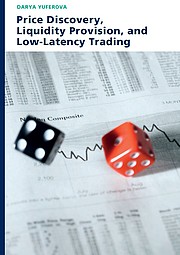Price Discovery, Liquidity Provision, and Low-Latency Trading Defended on Thursday, 30 June 2016
This dissertation consists of three empirical papers in the field of market microstructure. These papers investigate the impact of increased interconnectedness of the financial markets and the vast trading speed improvements on two important functions of financial markets: price discovery and liquidity provision.
Chapter 2 examines the role of liquidity and trading activity in the origination and propagation of shocks to prices across international equity markets. The findings show that equity markets are strongly interconnected with respect to the transmission of shocks to prices and trading activity, while liquidity dry-ups seem to be isolated events.
Chapter 3 analyzes the choice that an informed trader makes between market (consuming liquidity) and limit (supplying liquidity) orders and how this choice is affected by the rise of algorithmic trading. Darya's findings suggest that price informativeness does not necessarily come at the expense of low liquidity, even in the presence of algorithmic traders.
Chapter 4 examines whether low-latency traders are improving or deteriorating price discovery in the pre-opening period. The findings show that low-latency traders actively participate in the pre-opening period despite the absence of immediate execution, although to a lesser extent than during the continuous trading session. Furthermore, low-latency traders lead price discovery during the pre-opening period.
Overall, Darya's current and future research agenda is related to the design of the well-functioning financial market with specific focus on the regulation of the low-latency traders.
Keywords
Liquidity, price discovery, high-frequency trading












